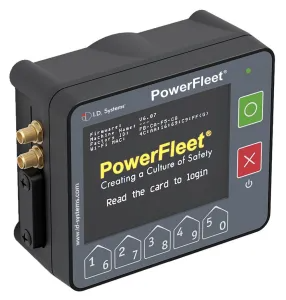Most managers appreciate the importance of forklift safety, given the high human and economic costs of an accident. However, while training is essential to reduce safety incidents, good driving habits also reduce fuel costs, extend truck lifespan, and improve overall workplace morale when everyone follows the same set of rules.
Let’s look at forklift training requirements and best practices on how to level up your training with telematics.
Forklift training is essential to meet OSHA compliance, ensure safety, and extend truck lifetime—and telematics can help improve your training. Share on XForklift Training Requirements
The Occupational Safety and Health Administration (OSHA) requires that all employees be trained and certified before operating a forklift—even if it’s only a tiny part of their job and regardless of industry experience or skill level. After all, an experienced operator may be unfamiliar with a new workplace environment, creating potential safety hazards even when they know how to operate a forklift.
The burden of these certifications falls on employers who are responsible for the training, evaluation, and certification of their drivers. However, OSHA does provide a 10-hour and 30-hour training program, and earning an OSHA 10 or OSHA 30 card by completing these courses is mandatory in some states, cities, and local jurisdictions.
Forklift training consists of three parts:
- Formal Instruction: Formal instruction provides background information about forklift safety and operations, typically delivered via books, lectures, videos, or online training. These courses may take place at the worksite or via online classes.
- Practical Training: Practical training includes hands-on instruction and practice under the supervision of a trainer. These sessions must take place at the workplace using the same equipment that the trainee will use on the job.
- Evaluation: Evaluations assess an employee’s performance and ultimately certify them. Employers must document these evaluations—and other training sessions—to comply with OSHA regulations and defend the company if an incident occurs.
The instruction also has several requirements:
- Trainees may only operate forklifts under the direct supervision of trained individuals until they’re certified.
- Trainees may only operate a forklift in a manner and place that doesn’t put other employees at risk.
- Only trained and experienced individuals can evaluate trainees.
- Training must emphasize forklift and workplace-related topics.
- Operators that train and pass evaluation must receive proof of their certification, including their identity and date.
After the initial certification, OSHA requires written and practical performance evaluations at least once every three years. In addition, OSHA requires refresher training when forklift drivers operate unsafely, are in an accident or near-miss, receive a poor review, or when there are changes in the workplace or type of tractor being driven.
How Telematics Improve Training
Industrial telematics platforms connect sensors to a central information hub to drive actionable insights. For example, you might outfit each forklift with a GPS tracking device that reports its location throughout the day. Then, you can use that data to discover the most popular routes, analyze the number of miles driven, or identify the most safe and productive operators.

Powerfleet’s OC series (OC-53, OC-55) and VAC-4S meets OSHA record keeping and reporting requirements while improving safety with automated safety checklists and more. Source: Powerfleet
There are many ways telematics can improve training:
- Enforce Certification: Driver sign-in and safety checklists ensure that uncertified drivers cannot access forklifts, while safety checklists help comply with OSHA regulations. You can also customize the checklists for drivers in training.
- Better Training Videos: Forklifts outfitted with video recording devices produce valuable training videos showing real-life examples of completing specific tasks, along with examples of good or bad behaviors in the actual workplace environment.
- Refresher Training: Sensors that monitor speed, detect impacts, and other adverse events alert managers of unsafe driving. That way, they can quickly provide refresher training to adhere to OSHA regulations and minimize safety incidents.
Managers can use telematics data to optimize fleet assets (e.g. relocate underutilized forklifts), monitor and improve productivity, right size fleets, and reduce safety incidents. Moreover, telematics have many use cases that lower their total cost of ownership and deliver a high return on investment.
Finding the Right Telematics Provider
Many companies provide telematics solutions for industrial environments such as warehouses and manufacturing facilities. When choosing a provider, you should look for a company with a long track record, industry expertise, and exceptional customer support. After all, a startup that goes out of business could leave you with worthless solutions, while poor customer support could result in high implementation costs.
Powerfleet has more than 25 years of experience in industrial telematics, with over 100,000 units deployed worldwide. Our goal is to help our customers realize a high return on investment through the use of telematics and other safety accessories for efficiency gains, safety improvements, and training optimization. We also provide telematics for logistics/transportation fleets for holistic visibility from fork to truck.
For example, we helped a large food manufacturing business reduce the risk of accidents by 70% and cut down on forklift damage by 80%, resulting in over $400,000 per year in savings. Many other companies have seen even greater returns from efficiency gains realized through the use of telematics across their business.
Learn how we can help your business.
The Bottom Line
Forklift training is essential to ensure safety, maximize productivity, and minimize expenses. While OSHA lays out some basic requirements, the most successful companies leverage telematics solutions to enforce certification, document examples of good and bad behavior, and identify individuals that may need refresher training before a serious incident occurs.
If you’re interested in gaining insights to your industrial operations to improve your bottom line and safety, Powerfleet can help you develop a strategy to deploy cutting-edge technologies across your forklift fleet.


